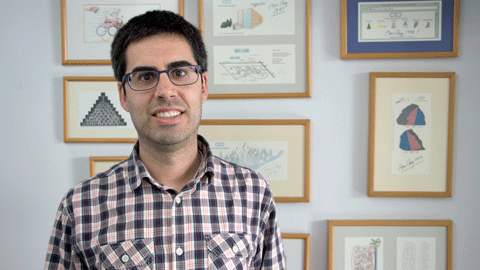"Time spent with one's partner depends mainly on cultural factors"

08/03/2016
Joan García Román, doctor in demography by the UAB and researcher at the Minnesota Population Center at the University of Minnesota, gave a conference entitled "Couples Shared Time Across Decades, Countries, and the Life Course" on 25 February at the UAB Centre for Demographic Studies (CED). The demographer talked on his studies on the evolution of time shared by couples in the past 50 years. His research also includes a comparative study of the time spent together by couples in the USA, France and Spain.
Tell us about your trajectory. Why did you decide to go to the University of Minnesota?
I earned my degree in Statistics and later presented my PhD theses at the CED, where I worked for 13 years. My thesis focused on the use of time among dual-income couples and I defended it in 2012. And that is how I began to work on issues related to time use. Later, I was looking for a post-PhD stay somewhere and the possibility of going to the Minnesota Population Center came up. I joined a project on the harmonisation of time use data. I planned to be there two years minimum and in July it'll be three years already.
What changes have there been in the past 50 years with regard to the time couples spend together?
Once in Minnesota, I was given the possibility of studying this issue with other researchers who had already conducted a survey in the US on who we spend our time with. We were able to observe changes which had taken place between couples from the 1960s up until 2012. Contrary to what we had observed in other studies, the amount of time spent together had not decreased but rather increased slightly despite the difficulty posed by modern working hours. We also saw differences between parents and non-parents and reached the conclusions that both types of couples had increased their time spent together, but that parents had basically increased the time they spent with their partner and their children.
Does the data help you detect inequalities between genders?
No, and this also surprised us. In other aspects of time use, gender is very present in the time dedicated to different activities, but here we did not find any significant differences.
What did you detect in relation to the reconciliation of work and family life?
The data reveals that even though both partners work now, spending time together is not more difficult than when only one of the partners worked.
Is there a connection between working conditions and the time they spend together?
We always look at couples in which at least one of the members works. The higher the social class the more time they spent together and the more they valued this time.
You also compared data from different countries. Are there big differences?
We compared Spain, France and the USA. We wanted to work with three culturally different countries, but use a similar methodology. We discovered that couples spend more time together in Spain than in France, and more in France than in the United States. In Spain, couples spend on average five and a half hours together every day. There is approximately one hour difference between the total time spent together in Spain and in the USA.
What factors cause this?
We tried to base it on the importance of work, but then discovered that work only explained a small part of it and that the difference was due mainly to cultural factors related to the use of time. The activities couples do most together are eating meals, leisure activities in general and watching television. In Spain and France the time spent eating meals is greater because mealtimes are longer. And in Spain, couples spend a lot of time together with their children. We also detected that Spanish schedules, which are a bit behind other countries, allow couples to spend more time together late at night: more couples are together at 11 pm in Spain than in France or United States.
With what data do you work?
We work with time use surveys. Participants are asked to fill in a 24-hour diary with the activities they carry out. They also have to explain if they do any secondary activities. For example, from this to that time I had lunch and watched television. The latest surveys also ask about internet use. And their location at the time of the activity: the workplace, street, home, etc. We also ask them to write down with whom they are. This information we include is whether they are with their partner, children, another member of the household, etc.
You mention the internet. This must be an important aspect in the study of relationships.
Yes, we have to take it into consideration especially in terms of time evolution. In the 1960s things were different in this area. For example, one of the most commonly shared activities between couples was watching television, and television in the 1960s has nothing to do with television today: there was no 24-hour programming; now, if you cannot watch a programme when it's on, you can watch it later; and so on. There are changes which affect the quality of the time spent together.
How will the research continue?
We are now studying the evolution of time spent together throughout the life cycle of the couple. We began by observing married and cohabiting couples and there aren't that many differences. Married couples spend a bit more time together, but they are quite similar. What we aim to do in the future, since we are studying couples aged 20 to 64 years old, is to focus on older couples: what happens after they turn 65.
More information:
Centre for Demographic Studies